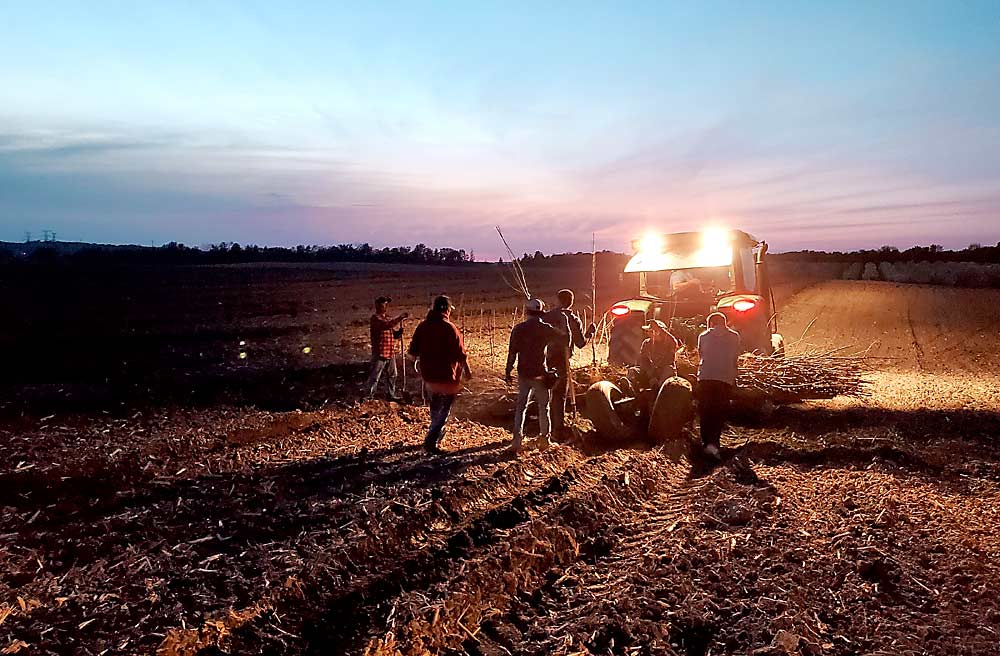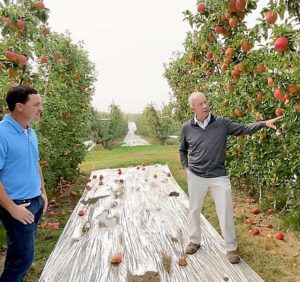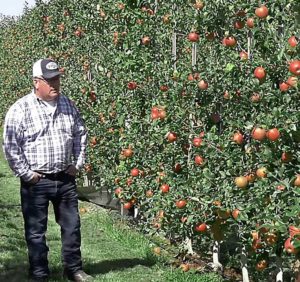
The first order of business at the International Fruit Tree Association’s annual winter conference, held virtually in February, was for its 2020 board members to give a regional roundup of planting trends in six North American fruit regions.
Nova Scotia
In Nova Scotia, growers have been planting aggressively in the past few years, and there are a lot of young plantings and orchards not yet in full production. Honeycrisp, Ambrosia and club varieties are the most popular plantings. The most popular rootstocks are Malling 9, M.26 and Geneva 935. Most new plantings have 2 or 3 feet between trees, and 10 or 12 feet between rows, said Lisa Jenereaux, 2020 chair of IFTA’s board of directors and a Nova Scotia grower.
Nova Scotia contains about 4,000 acres of orchards, farmed by 75 commercial fruit growers, the majority in the Annapolis Valley. Many of the province’s growers are now doing their own nursery work, because they were tired of waiting for their preferred rootstocks and paying the cost of exchange rates and shipping, she said.
Variable weather has been an unwelcome trend in the last few years. There was a bad freeze in 2018 and hail and hurricane damage in 2019. Growers mitigate risks with wind machines, trickle irrigation, hail netting and tile drainage, Jenereaux said.
New York
Brett Kast, orchard manager at Kast Farms in Western New York, said apple plantings in his region continue to tighten, with row spacings down to 10 or even 8 feet and tree spacings down to 2 feet. Rootstocks such as G.11, G.41 and G.935 are on the rise, but Budagovsky 9 and M.9 variants are still in use. Growers are starting to use Nic.29 and B.10 for their cold-hardy attributes.
New York growers also are starting their own nurseries, and they’re leaving trees in the nursery a year or two longer than they used to or are grafting over less-desirable varieties, Kast said. There’s less of an emphasis on club varieties than there was a few years ago.
Kast said there’s been a greater emphasis on mechanization and precision crop load management: bud counting, detail pruning, the pollen tube growth and carbohydrate thinning models. More growers are adopting reflective fabrics and hail netting and are hiring H-2A workers to deal with labor shortages.
Illinois
Illinois’ apple acreage is holding steady. Popular varieties include Honeycrisp, Fuji, EverCrisp, Jonathan and Golden Delicious, and popular rootstocks include Genevas and M.9 clones, said Craig Tanner of Tanners Orchard in Speer.
The Illinois apple industry is oriented toward direct sales, with most farm markets and U-picks located in the northern half of the state and serving greater Chicago.
“It’s getting to be less and less about fruit and more about agritainment,” Tanner said.
Michigan
Michigan’s apple plantings remain fairly steady at about 35,000 acres (most of them within 45 miles of the Lake Michigan shoreline), but growers are seeking good sites and planting more orchards on land that has never before held fruit, said Jim Engelsma, a Michigan grower and crop advisor for Nutrien Ag Solutions.
Many growers are putting in large plantings of Honeycrisp, Fuji, Gala, EverCrisp and club varieties. Spacings range from 3 feet by 12 feet to 2 feet by 10 feet, trained to super spindle, tall spindle and V systems.
Michigan produces about 75 percent of the country’s tart cherries. New plantings are still replacing older plantings, though the state’s overall tart cherry acreage has declined slightly, Engelsma said.
British Columbia
British Columbia’s apple acreage has declined significantly in the past few years, due to low prices and hail damage. The few apple trees being planted are spaced at 2 feet by 10 feet in super spindle systems, mainly on Malling rootstocks, said grower Hank Markgraf of H&S Productions in Kelowna.
The vast majority of the former apple land is being replaced by sweet cherry plantings. Varieties include Sweetheart and Staccato, mainly on Mazzard rootstocks with some Gisela and Krymsk. British Columbia cherries come to market after other regions have finished their seasons, so the later the variety, the better, he said.
Pear acreage is holding steady, and growers are sticking with traditional varieties such as Anjou, Bartlett and Bosc on OHxF rootstocks.
Challenges include labor shortages, high land prices and finding new markets for all those new cherries, Markgraf said.
Washington
A lot of orchard removal is happening in Washington state, with older varieties being taken out of the mix, along with unprofitable Galas and Honeycrisps that didn’t fill their space, said Jeff Cleveringa, head of research and development for Oneonta Starr Ranch Growers, based in Wenatchee.
Few orchards are being replanted right now. Even Cosmic Crisp plantings have slowed. There will be a Cosmic Crisp “tsunami” hitting the market in the next few years, and growers are waiting for the “shakeout” before deciding what to plant next, he said.
“We’ll see what varieties are left when that retreats,” he said.
Growers are approaching new varieties more cautiously than they were several years ago. The money needed to replace an orchard is not as accessible as it used to be, and they know many new varieties aren’t going to succeed in the increasingly competitive marketplace.
As for growing systems, Washington’s “age-old discussion” of V trellis versus vertical wall has changed slightly. The focus of the discussion used to be on productivity, but now it’s on automation and labor. Growers no longer have the excess labor needed to train and tie down a V system. And the vertical wall — with its access to fruit on both sides of the tree — seems to be the clear choice for growers who want to automate, Cleveringa said.
There’s also a greater emphasis on precision farming with less labor. There aren’t enough workers available to double hand thin, for example, so growers have to get it right at pruning time.
“Growing nontarget fruit, the wrong size, the wrong color — there’s no forgiveness in the market for that anymore,” he said. “The luxury of having extra people isn’t there anymore. Every task counts to the utmost degree of precision.” •
—by Matt Milkovich









Leave A Comment